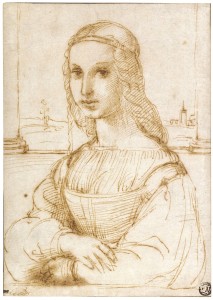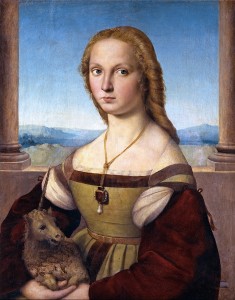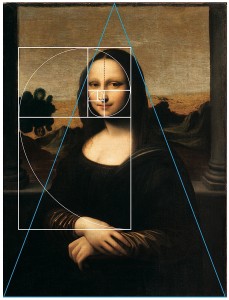By Professor Átila Soares da Costa Filho, Author, Art History, Philosophy and Sociology Expert.
Among approximately sixty alleged “Mona Lisas” – or “Giocondas” – that are located across Europe, the U.S.A. and Japan, one seems to stand out for its uniqueness: the “Mona Lisa of Isleworth” or “Mona Lisa – The Earlier Version“, an oil on canvas [86.0 X 64.5 cm], slightly larger than the celebrated version of the Paris Louvre (79.2 X 53.3 cm). Basically, though the Paris and earlier paintings are very similar, one is at first struck by the fact that the model in the first [or “earlier”] version is shown to be younger and more beautiful.(See Fig 1)
The recent origins of the painting point to when it leaves the Florentine residence of Francesco Del Giocondo – its owner – in the mid-eighteenth century on its journey to Britain, where it would become part of the heritage of an aristocratic Somerset family for nearly two centuries. In late 1913, the painting was acquired by Hugh Blaker, a celebrated art connoisseur, dealer, and curator of the Holburne Museum of Art, in Bath, who transferred it to his home in Isleworth, a suburb of west London. During the First World War, for security reasons, the painting was sent to the United States, where it was displayed at the Boston Museum of Art. In the early 1920s, after its return, the painting was brought to Rome, where many Leonardo experts of the day acclaimed it as the work of Leonardo da Vinci. Later, in 1962, the specialist in arts, Dr. Henry F. Pulitzer, together with a Swiss consortium, became the new owner of the work. Initially, the painting remained in his Kensington apartment in London. Pulitzer subsequently authored a major study of the painting: his book – ‘Where is the Mona Lisa?’ – was published in 1966. At the present time, the painting is maintained by an international consortium. It has fallen to The Mona Lisa Foundation (headquartered in Zurich) to undertake the task of researching all about the painting, and the dissemination and worldwide promotion of all the results.
Lisa, the young ‘Gioconda’
The character of the “Earlier Mona Lisa“, in the opinion of the late Dr. Pulitzer, and of The Mona Lisa Foundation, is that she was the real Mona Lisa (“mona”, which, in old Italian, means “lady“), a woman 11 or 12 years younger than the figure portrayed in the Louvre – who was about 34 years old at the time the Louvre portrait was completed. The model in the “Earlier Version”, Lisa di Antonmaria Gherardini, was the wife of a wealthy Florentine silk merchant and emerging politician, Francesco Del Giocondo.
![Spreads - Paints to compare - 2 Leonardo da Vinci 'Mona Lisa' [Louvre Version c. 1513-1516 - left; and Earlier Version c. 1503-1506 - right].](http://monalisa.org/wp-content/uploads/2012/10/Spreads-Paints-to-compare-2-300x208.jpg)
Figs. 2 & 3 Leonardo da Vinci ‘Mona Lisa’ [Louvre Version c. 1513-1516 – left; and Earlier Version c. 1503-1506 – right].
However, unlike Pulitzer, the opinion of The Mona Lisa Foundation is that both the ‘Isleworth’ and Louvre versions represent the same woman. Therefore, it is Lisa at the Louvre, not Constanza. One of the strongest arguments for this theory – almost definitive proof – is the reference by Antonio de Beatis, secretary of Cardinal Luigi of Aragon, when visiting Leonardo in 1517 in France, where the artist was living at the invitation of Francis I. There, Don Antonio referred to one of the paintings shown by the artist as (a picture of) “ … a certain Florentine woman, made from life, at the instance of the late Magnificent Giuliano de ‘Medici” By the date of the event, we can clearly understand that that portrait is the one now in the Louvre, that came into the French royal collection along with the “Virgin and Child with St. Anne”, and “St. John the Baptist”, also cited by de Beatis; and, therefore, Costanza, being of Neapolitan origin, would be definitely ruled out of any chance as being a candidate for the Louvre version.
A Controversial Theory
Considering that Leonardo never left any notes about his portraits of Mona Lisa, perhaps the writings of one of the greatest artists and biographers of the Italian Renaissance, Giorgio Vasari, could decisively assist in putting an end to this controversy. Vasari could never have seen the ‘Louvre Mona Lisa’, as he was only five years old when Leonardo took it to France in 1516, and he himself never visited that country. However, he would describe in great detail a painting with the same characteristics as the ‘Isleworth’ version, in the house of Francesco Del Giocondo, his friend. There are records that show that Vasari could have visited the del Giocondo residence in the 1530s.
In addition, the distinguished artist and chronicler, Giovanni Lomazzo, in 1584 mentions two works which he identifies as “della Gioconda” AND “di Mona Lisa“, making a clear distinction that there were two works. Moreover, in a letter from Fra’ da Novellara to Isabella d’Este, there is a reference about Leonardo’s assistants working on two portraits – and, by the date, can be concluded then, that two versions of the Mona Lisa were underway. Novellara’s correspondence identifies other religious images being executed in Leonardo’s atelier; but the two portraits mentioned above must have then been ‘secular’, and the only known secular commission that Leonardo was working on at the time was the portrait of Lisa Del Giocondo. Furthermore, in Cloux in 1517, the secretary of the Cardinal of Aragon, Antonio de Beatis, notes conversations directly with Leonardo, and makes it clear from the observations of the works shown by Leonardo that the Louvre version was commissioned by Giuliano de Medici.
Other relevant data:
1) One of the specialists called in 1913 to examine the Louvre ‘Gioconda’ after its return to Paris (it was stolen from the Louvre in 1911), Prof. Commendatore Lorenzo Cecconi, Curator of the Academy of Santa Luca, subsequently authenticated the ‘Isleworth’ version as a Leonardo, when he saw it in Rome in 1922.
2) John Eyre, author and art connoisseur, in his publication: ‘The Two Mona Lisas’ (1924), identified the hands and face of the ‘Isleworth’ version as unquestionable marks of Leonardo. Eyre also wrote the first major scholarly article about the ‘Isleworth’ version, in 1915, called ‘Monograph on Leonardo da Vinci’s “Mona Lisa” ‘.
3) According to an article in ‘The Century Magazine’ (February 1914), ‘The Two “Mona Lisas” ‘, signed by Walter Littlefield, yet another version, the now newly-restored ‘Gioconda Velata’, of the Prado Museum (Madrid), had been acquired by Charles I of Spain just to compete with Francis I of France, and his “original”. This painting was seen as legitimate at the time, but the whole glamorization and mystique of Paris gradually “blurred” its importance and legitimacy. However, today the authorship of the ‘Velata’ has been tentatively attributed to Salai or Francesco Melzi, Leonardo’s assistants, but this has also not been proven. The background – previously overpainted in black – has been removed, revealing a scenario analogous to the Louvre version, though either one could have originated as a copy of the ‘Mona Lisa (Isleworth)’.(See fig 4)
Claims continue to arise about the possibility that these two models (the ‘Isleworth’ and the Louvre versions) are actually the same woman (followed by the Spanish version, in better condition). Moreover, an additional thesis claims that the character of the Louvre version has been affected by the varnishes and craquelures: that these might have given the appearance of “aging” the face. The problem with this theory is that if this were the case, then all that has been written and spoken about in recent centuries concerning old paintings should be discarded, since most of them suffered the same ageing processes and this had never been a hindrance to the experts who understand the age of any picture. Furthermore, these effects only become noticeable when the face of a model is seen more closely, which would force the viewer to escape the proposed Renaissance contemplation of the human figure in its entirety – and that can only be achieved at a distance. Hence we conclude that craquelures and related varnishes never had the power to interfere to the point of subtly confusing youth with maturity. In my opinion, if the model of Paris appears to be older than her cousin in Madrid, it was so because it was intended that way, even if they are based on the same ‘cartone’ (preparatory drawing). Also, the woman in the Prado copy is very different and much younger than the Louvre version. Therefore, the visual evidence suggests that the “youthfulness” of the Prado ‘Velata’ emerged from an original, other than the Louvre version.
Discussions and Further Evidence
Pulitzer argued that scholars have a tendency to dislike when a work of some unprecedented genius arises, often because of the risk and trouble of having to reconsider many of their sources of production research; hard-built theories that could invalidate an academic name. Since the days of Pulitzer’s Swiss consortium, and later, after another international group became owners of the work, the painting has undergone a veritable crusade in order to confirm it as originating from da Vinci’s own hands; and, moreover, depicting the same woman as in the Louvre version – which would ultimately suggest further studies.
To this end, The Mona Lisa Foundation has made every effort so that the painting would meet the widest possible range of evidence from different fields of knowledge, by following righteously all the necessary and relevant criteria for scientific and historic research. Renowned experts in these fields, such as Prof. Alessandro Vezzosi, director of the Museo Ideale Leonardo Da Vinci – a leading authority on Leonardo in the world – and Prof. John F.Asmus, Research Physicist at the University of California, San Diego, have played a leading role. The results of over thirty-five years of intensive research recently became available to the general public with the launch of a new website (http://monalisa.org), and a substantial companion publication, ‘Mona Lisa – Leonardo’s Earlier Version’. Thus, the findings seem to indicate the fact that, really, the painting is an authentic Leonardo, and that the ‘Isleworth’ woman is a young Lisa Gherardini, 11 to 12 years younger than the version in the Louvre.
A big boost this theory was the discovery in 2005 at the University of Heidelberg (Germany), of notes from a secretary of Machiavelli, Agostino Vespucci, who witnessed Leonardo working on the portrait of Lisa del Giocondo – these notes are dated 1503.(See fig. 5) Note that today, much of the academic world now agrees that the Louvre ‘Gioconda’, for reasons of specific style and techniques, had been mainly executed sometime after 1508, and completed possibly as late as 1516/1517.
About criticism that the work can not be an original because it is on canvas rather than wood (at the time, by far the most used support), I imagine that this would amount to, in five hundred years from now, that scholars of the Cultural History of the Twentieth Century flatly refusing to admit that Tom Hanks may be the same actor from ‘Philadelphia’, or ‘Saving Private Ryan’, only to also have been the protagonist of the most popular comedies of the 1980s! … The Louvre itself has other examples: studies of drapery painted on canvas. If we admit that a true artist who is a genius, would be “open” to any and all types of innovations and experiments – including to exercise his art – it is no surprise that this same inquisitiveness would manifest itself in exploring new avenues, and leaving the popular aside for a while. This vocation had even been the reason for the disaster that struck his second most famous work, ‘The Last Supper’ in Santa Maria delle Grazie, Milan, that deteriorated quite badly and rapidly due to an unreliable tempera technique that failed almost immediately. A similar disaster occurred, around the time of the ‘Earlier Mona Lisa’, with his experimental work in Florence for the ‘Battle of Anghiari’ fresco. It is particularly curious: when Leonardo the painter came out, in his own lifetime, with a new experiment, whether it worked or not, it was routinely accepted as his work; yet in the case of the ‘Earlier Version’ of Mona Lisa, where his work was executed perfectly, it is impossible to give him credit? This makes no sense. In fact, Leonardo had also written on the subject of “canvas” in his ‘Trattato della Pittura’, published posthumously in 1651.Symbols of the Renaissance
Aspects of the composition and execution of the painting; the hands and face are portrayed uniquely “Leonardesque”, and these elements must certainly have been executed by the master. In addition, all the treatment applied to the main elements of the composition perfectly fits Leonardo’s drawing style, as well as his very high technical level. Furthermore, the head, neck, and bases of the columns, indicate the brushstrokes of a left-handed artist – as da Vinci was known to be. The identical ethereal atmosphere that can be applied to the Louvre version, is also recognizable here. Making use of ‘sfumato’ – a painterly device for blending skin-tones and other colours, quite typical of the Italian Renaissance – gives a supernatural effect, an aura of mystery to the composition. If you do not experience these same emotions that mark both, that recreation of an “unreal” universe outside our space-time – you can assign it to the habit of the master to not finish what he had begun to produce, as well as an “outsourcing” of work to the hands of assistants. Unlike any other case of a copy of this work, this painting remains true to the stylistic fidelity and pictorial principles of the Anchiano artist. Elsewhere, as already mentioned, the treatment given to the rest of the composition, like the background landscape – which is very simple – seems to point to a collaborative work, especially in view of Leonardo’s taste for detail, as well as his great interest in natural themes.
In addition, this version features Lisa between two Greek columns – a clearly Renaissance element – nonexistent in the original composition of the Paris version, but present in a sketch made by Raphael (c. 1504)(see fig. 6), and also in a subsequent oil painting by him: the ‘Lady with a Unicorn’ (c. 1505)(see fig. 7), i.e., in the same period in which Leonardo worked on this younger Mona Lisa. It is worth noting that recent examinations have demonstrated that the ‘Mona Lisa’ from the Louvre never had its sides trimmed – a commonplace procedure at the time and subsequent centuries in order to perfectly fit a picture into a previously prepared frame.
The “Isleworth” also follows the use of the “golden section” (or “golden ratio”) as authenticated in some other works of Leonardo (‘The Annunciation’ from the Uffizi in Florence, and the ‘Mona Lisa’ from the Louvre are good examples). The “golden section” is a structural resource for mathematical compositions in art and engineering, discovered in antiquity, and widely used in the Renaissance, which opposes the principle of intersecting axes. Thus, the artist can, through the strategic subdivision of the image into several rectangles, produce a series of major and minor shares that would flow to infinity. This effect guides our vision spiral, resulting in a transcendent order in space. Therefore, a painting would reflect a natural rhythm – indeed, the observation and study of nature (scientific logos) were pillars of paramount importance in Renaissance achievements.(See Fig. 8)
It is here that the two-dimensional plane is seen in critical perspective, and because of the “golden section”, the figure of greatest interest (in this case, the woman) would integrate everything together. That is, through the iconographic image of the schematic model of Lisa Gherardini, we can see the imagination of Leonardo’s desire where this “New Man” sees his own genre integrated as both the natural forces of life and the world.
Philosophical Implications
Another relevant Renaissance factor in the “Earlier Version” is the part of Leonardo’s keen interest in the search for an ideal of upper beauty (order): the question of the “dual principle”, or “opposites” in things – which brings us back to Heraclitus of Ephesus and his thoughts on the cosmos and the “one”, and development with harmony. Also, studies of Fibonacci and the “golden ratio”, including the strength of symmetrical balance, would be of singular importance in Leonardo’s compositions. In particular, in the iconography of da Vinci with the theme of youth and maturity, we have some examples of how such philosophical implications seduced the genius of the artist-designer.
A good example of the different aspects of this complexity, where each of us is our own universe, is preserved in a drawing at Christ Church College, at Oxford University: his ‘Allegory on Politics’, executed between 1483 and 1487. Here we have two mystical ladies with a “magical” mirror, in addition to some ancient symbols for alchemy and hermeticism (control of the natural elements), i.e., the presence of birds and serpentine elements: electricity and magnetism. One of these women is presented in this gestalt with a young face, and another like an old man. In fact, the theme of the transience of Man was another constant in the philosophies and the occult arts, from the Middle Ages to the Renaissance, and continuing (more recently) to Romanticism and Expressionism. Christ Church College also retains another drawing called ‘Allegory of Pleasure and Pain’, from 1480, which sees two male figures – one young, one old – that emanate from the same body. The idea here is to illustrate the need for the existence of pleasure from pain, and vice versa: once again, the issue of one and the opposite.(See Fig 9)
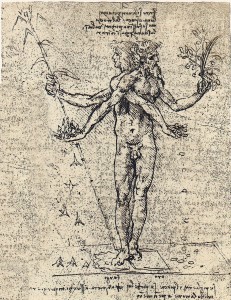
Fig. 9 Leonardo da Vinci ‘Allegory of Pain and Pleasure’, c. 1480, Christ Church Picture Gallery, Oxford.
Other cases in the same genre are Leonardo’s oil on wood ‘The Adoration of the Magi’ in the Uffizi in Florence, begun in 1481 and left unfinished from 1482. Here, in detail, we see a group of young people around a foot locust tree, in contrast to the group of seniors that surrounds the main scene; and the cartoon: the ‘Virgin and Child, with St. Anne’, (1499-1500), an imaginary scene that contrasts Mary’s youth to the maturity of her mother. The interesting thing here is that these two characters have a strong physical resemblance to Lisa Gherardini in their roles as young (Earlier Version) and mature (Louvre version), respectively.
So ‘Mona Lisa – Earlier Version’, the younger counterpoint to the classic version of Paris, adds to the iconography of opposites created in Leonardo’s works. His intentions in relation to the Louvre version is more than clear: the very general aspect of the image itself reveals a clear representation of a rejuvenation of ‘La Gioconda’.
There is, in my view, still one more strong circumstantial element: the slight presence of a cosmetic on the lips of the young Lisa Gherardini, which only further supports the direct relationship between the two versions: one young, one older. At the turn of XV-XVI centuries, the use of these materials with reddish tones was extremely inappropriate for mature women. Several studies to restore the original colours in the Louvre ‘Gioconda’ demonstrated that her lips would not be much more coloured than they appear today.
The ‘Gioconda’/’Mona Lisa’ of the Louvre, finally, to Leonardo, could only have existed if there was also another point of balance through an earlier version, upon which he could further exercise his higher level of thinking, where opposites would of necessity orchestrate the movement of history, and of all creation.
Conclusion
To see the famous smile of the ‘Mona Lisa’ in Paris, the world embarks on endless “pilgrimages” to the Louvre. That her figure has become synonymous with the greatness the human race is capable of creating, as Kennedy spoke once – something that, at first glance, would supplant all its other achievements – while it enchants the viewer and sits elegant and robust in the face of eternity: it is sensitivity and solidity. Certainly, in the ‘Earlier Version’, the result is not different: the sovereign pose and smile so unique are also evident in this graceful variation, with both ‘Monas Lisas’ composing the image, the ideal portrait of our humankind at the dawn of Modernity, and in the countenance of the woman, we see humanity.
Considering all these things, we can reflect that Leonardo da Vinci’s ‘Isleworth / Earlier Version’ could certainly expand our understanding of the ‘Gioconda’ of the Louvre; on da Vinci himself; Lisa; her city; her time; and the universe where all these elements are in harmony: in short, about the fascinating world of studies on the transition from the Middle Ages to Modernity.
Átila Soares da Costa Filho, October 2012.
[Translated from the original Portugese]
Átila Soares da Costa Filho is Professor and the author of the book “A Jovem Mona Lisa e outras questões curiosas na História da Arte”, numerous articles in magazines and newspapers and a well respected voice on the History of Art in Latin America. For further reference, his homepage is here, and academic record here.

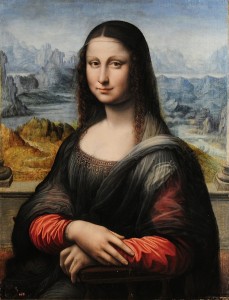
![fig.05-Heidelberg Document [extract] Fig. 5 'Heidelberg Document' extract (Notation dated 1503).](http://monalisa.org/wp-content/uploads/2012/10/fig.05-Heidelberg-Document-extract-300x90.jpg)
